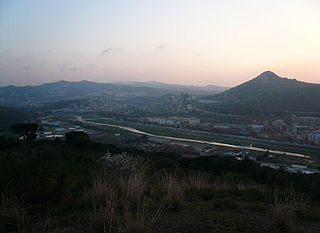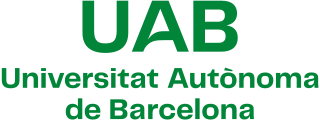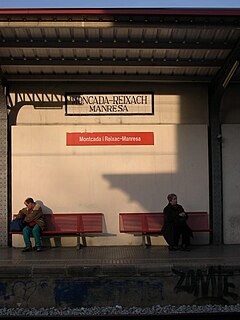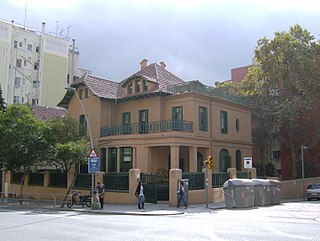
Vallès Occidental is a comarca (county) in Catalonia, Spain. It is unique among the comarques in that the two cities Sabadell and Terrassa share the role of comarcal capital. Along with Vallès Oriental it forms the grand comarca of Vallès.

Trambesòs is a tram–light rail system in the Spanish autonomous community of Catalonia that links the Barcelona district of Sant Martí with Badalona and Sant Adrià de Besòs. Its name comes from the union of the words "tram", an abbreviation of the Catalan word for "tram" (tramvia), and "Besòs", the name of an area in the north of the Barcelonès region dominated by the Besòs River.

Sant Adrià de Besòs is a city and a municipality within the comarca of Barcelonès in Catalonia, north-eastern Spain. It is situated on the Mediterranean coast, at the mouth of river Besòs, extending to both sides of the estuary although the original settlement with the parish church lies on the left bank of the river, in the northern part of town. Sant Adrià is the smallest municipality of Barcelonès and has close ties with the neighbouring cities of Barcelona, Badalona and Santa Coloma de Gramenet, forming a uniform urban area within Barcelona metropolitan area.

The Vallvidrera Funicular is a 736.6-metre-long (2,417 ft) funicular railway in the Barcelona district of Sarrià-Sant Gervasi, in Catalonia, Spain. It connects Peu del Funicular station on the Barcelona–Vallès Line with the residential neighborhood of Vallvidrera, in the Collserola mountain range.

The Barcelona–Vallès Line is an unconnected standard gauge railway line linking Barcelona with Sabadell and Terrassa via the Collserola mountain range, in Catalonia, Spain. Its name refers to the Catalan historical region of Vallès, whereby most part of the line runs. Plaça de Catalunya station serves as the Barcelona terminus of the line, where almost all its trains either start or terminate. The line then continues northwards and branches off twice before leaving the city limits. Its main route splits in two in Sant Cugat del Vallès, forming two major branches to Sabadell and Terrassa. It has 40 passenger stations in operation and a total line length of 48.1 kilometres (29.9 mi).

The R3 is a line of Rodalies de Catalunya's Barcelona commuter rail service, operated by Renfe Operadora. It runs northwards from the Barcelona area to the French border town of Latour-de-Carol, passing through the Vallès Oriental, Osona and Ripollès regions. With a total line length of 165.9 kilometres (103.1 mi), it extends notably beyond the limits of the Barcelona metropolitan area, reaching the Pyrenees mountains. According to 2008 data, the line's average weekday ridership is 22,841.

The R4 is a line of Rodalies de Catalunya's Barcelona commuter rail service, operated by Renfe Operadora. It runs northwards from the northern limits of the province of Tarragona to Barcelona, passing through the inland Alt Penedès region. The line then continues towards central Catalonia, describing a U-shaped route through the Barcelona area. According to 2008 data, the line's average weekday ridership is 105,935, the highest on any line of the Barcelona commuter rail service after the R2.

The R7 is a line of Rodalies de Catalunya's Barcelona commuter rail service, operated by Renfe Operadora. It links Sant Andreu Arenal railway station in northern Barcelona with Cerdanyola Universitat railway station, which serves the Bellaterra campus of the Autonomous University of Barcelona. The R7 shares tracks for most of its length with Barcelona commuter rail service lines R3 and R4, as well as regional rail line R12. According to 2010 data, the line's average weekday ridership is 8,140.

Rail transport in Catalonia operates on three rail gauges and services are operated by a variety of public operators:

The following outline is provided as an overview of and topical guide to Catalonia:
Public transport in Barcelona is operated by several companies, most of which are part of the Autoritat del Transport Metropolità, a transport authority managing services in the Barcelonès and the rest of the metropolitan area of Barcelona. This article is a summary with transport facilities and services strictly within the municipality of Barcelona, and contains links to more specific articles.

Public transport in Santa Coloma de Gramenet is an important part of the Metropolitan Area of Barcelona transportation network. Santa Coloma is a densely populated suburb of the city of Barcelona which fulfills both the role of dormitory town and one of the biggest settlements in the capital's urban area, at around 120,000 inhabitants, and is straddled by Barcelona's Nou Barris and Sant Andreu districts, Badalona, Sant Adrià de Besòs and Montcada i Reixac. The town still relies mostly on bus lines for transportation, but essential improvement arrived in late 2009 with the partial construction of Barcelona Metro line L9. In the future, Generalitat de Catalunya will construct a new line of Tram.

Public transport in Cornellà de Llobregat is an important part of the transportation network spanning the Metropolitan Area of Barcelona. The city of Cornellà, a mostly working-class area with strong dormitory town traits, is one of the most populated in the Baix Llobregat with about 90,000 inhabitants and a daily destination for thousands of commuters in the urban area of the capital.

Public transport in Esplugues de Llobregat has been improved in recent years with the introduction of tram lines for the surrounding region in 2004, which provided better interconnection between municipalities and the capital Barcelona. This locality belonging to the Metropolitan Area of Barcelona and located in the comarca of Baix Llobregat is a wealthy suburb of the neighbouring Barcelona.

The R8 is a line of Rodalies de Catalunya's Barcelona commuter rail service, operated by Renfe Operadora. It runs hourly between Martorell and Granollers across the Vallès Occidental region, spanning 40 kilometres (25 mi) and eight stations. The R8 primarily uses the Castellbisbal–Mollet-Sant Fost railway, as well as the Sant Vicenç de Calders–Vilafranca del Penedès–Barcelona and Barcelona–Cerbère railways on its southern and northern ends, respectively. It is currently the only line of the Barcelona commuter rail service entirely bypassing Barcelona. The trains operating on the line are Civia electrical multiple units (EMU).
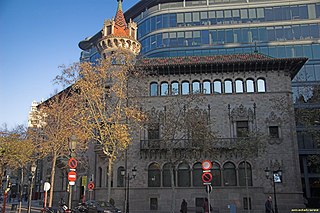
The Barcelona Provincial Council Local Museum Network, also known as Catalonia’s Biggest Museum, is a tool for support and collaboration from and for the museums of the province, which makes available to municipalities a series of services and actions aimed at improving, through the provision of direct services and research into viable formulas for supramunicipal cooperation, the management, conservation and dissemination of heritage and the museum facilities of the towns of Barcelona province. It is managed from the Cultural Heritage Office, which in turn depends on the Department of Knowledge and New Technologies of Barcelona Provincial Council.

Sant Adrià de Besòs and Estació de Sant Adrià are a Rodalies de Catalunya commuter rail station and a Trambesòs tram stop, respectively, together forming an interchange station complex in Sant Adrià de Besòs, to the north-east of Barcelona, in Catalonia, Spain. The Rodalies de Catalunya station is on the Barcelona to Maçanet-Massanes via Mataró railway, between Barcelona El Clot-Aragó and Badalona. It is operated by Renfe Operadora and is served by Barcelona commuter rail service line R1 and Girona commuter rail service line RG1. The Trambesòs stop is the northern terminus of routes T4 and T6 and is operated by TRAM.



